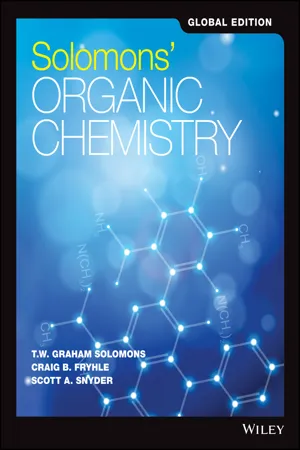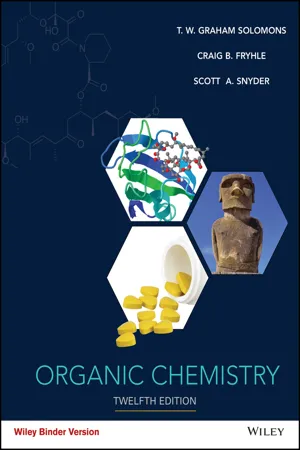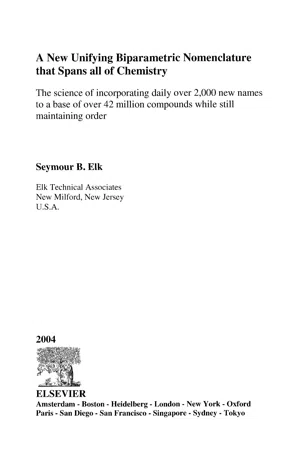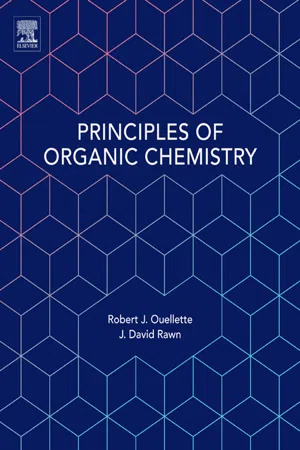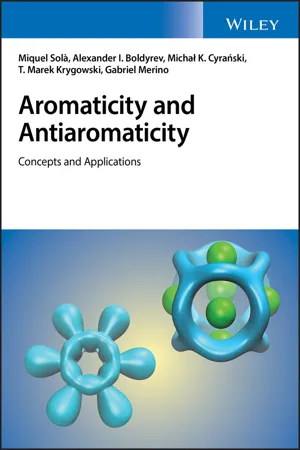Chemistry
Aromatic Nomenclature
Aromatic nomenclature refers to the systematic naming of aromatic compounds, which are organic molecules containing a ring of atoms with alternating single and double bonds. The nomenclature follows specific rules to designate the positions of substituents on the aromatic ring and to indicate the type and number of atoms in the ring. This naming system helps chemists communicate and differentiate between different aromatic compounds.
Written by Perlego with AI-assistance
Related key terms
1 of 5
7 Key excerpts on "Aromatic Nomenclature"
- eBook - ePub
New Frontiers in Nanochemistry: Concepts, Theories, and Trends
Volume 1: Structural Nanochemistry
- Mihai V. Putz, Mihai V. Putz, Mihai Putz(Authors)
- 2020(Publication Date)
- Apple Academic Press(Publisher)
CHAPTER 4Aromaticity
MIHAI V. PUTZ1, 2 and MARINA A. TUDORAN2
1 Laboratory of Structural and Computational Physical Chemistry for Nanosciences and QSAR, Biology-Chemistry Department, West University of Timişoara, Pestalozzi Street No. 44, Timişoara, RO-300115, Romania, Tel.: +40-256-592638, Fax: +40-256-592620, E-mail: [email protected] , [email protected]2 Laboratory of Renewable Energies-Photovoltaics, R&D National Institute for Electrochemistry and Condensed Matter, Dr. A. Paunescu Podeanu Str. No. 144, Timişoara, RO-300569, Romania4.1 DEFINITION
According to the IUPAC definitions, the aromaticity concept is referring to a spatial and electronic structure of cyclic molecular systems, which displays the cyclic electron delocalization effects. An aromatic compound present enhanced thermodynamic stability, which is relative to acyclic structural analogs, and tends to retain the structural type during the chemical transformations.4.2 HISTORICAL ORIGIN(S)
The word “aromatic” as a chemical term was used for the first time by August Wilhelm Hofmann in 1855 and was referring to compounds containing the phenyl radical (Hofmann, 1855). In 1865, August Kekulé proposed the cyclohexatriene structure for benzene, structure accepted by most chemists, due to the fact that it respects the isomeric relationships of aromatic chemistry known at that time, even if the unsaturated molecule of benzene was unreactive toward addition reactions. After J.J. Thomson, who discover the electron, placed three equivalent electrons between each carbon atom in benzene in 1921, and along with the introduction of the term aromatic sextet as a group of six electrons resisting disruption by Sir Robert Robinson in 1925 (Armit and Robinson, 1925), the stability of benzene was explained. Still, the quantum mechanical origins of aromaticity were modeled for the first time in 1931 by Hückel who separate the bonding electrons in sigma and pi electrons. - eBook - PDF
- T. W. Graham Solomons, Craig B. Fryhle, Scott A. Snyder(Authors)
- 2017(Publication Date)
- Wiley(Publisher)
617 C H A P T E R 14 In ordinary conversation, the word “aromatic” conjures pleasant associations—the odor of freshly prepared coffee, a warm cinnamon bun, a freshly cut pine tree. Similar associations occurred in the early history of organic chemistry when pleasantly aromatic compounds were isolated from natural oils produced by plants. Once the structures of these materials were elucidated, many were found to possess a unique, highly unsaturated, six-carbon structural unit also found in benzene. This special ring became known as the benzene ring. Aromatic compounds that contain a benzene ring are now part of a much larger family of compounds classified as aromatic, not because of their smell (since many of the molecules that contain them have no odor—for example, aspirin), but because they have special electronic features. IN THIS CHAPTER WE WILL CONSIDER: • the structural principles that underlie the use of the term “aromatic” • the initial challenge of determining the correct structure of benzene • a rule that helps to predict what kinds of molecules possess the special property of aromaticity • special groups of molecules that are also aromatic Aromatic Compounds photo credits: (pine needles) Diana Taliun/Shutterstock (bottles with essential oils): Madlen/Shutterstock 618 CHAPTER 14 AROMATIC COMPOUNDS ▸ WHY DO THESE TOPICS MATTER? At the end of the chapter, we will explore the question of just how large the rings of these molecules can be and still be aromatic, noting that chemists have been able to make aromatic rings larger in size than those of molecules obtained from nature, but largely by using design clues derived from those natural molecules. 14.1 THE DISCOVERY OF BENZENE The following are a few examples of aromatic compounds, including benzene itself. - eBook - PDF
- Stanley E. Manahan(Author)
- 2009(Publication Date)
- CRC Press(Publisher)
Aromatic compounds have , in Figure 9.7. Aromatic compounds have ring structures and are held together in part by particularly stable bonds that contain ring structures and are held together in part by particularly stable bonds that contain delocalized clouds of so-called delocalized clouds of so-called p (Greek letter pi) electrons. (Greek letter pi) electrons. In an oversimplified sense, the structure of benzene can be visualized as In an oversimplified sense, the structure of benzene can be visualized as resonating between the two equivalent structures shown on the left in Figure 9.7 by resonating between the two equivalent structures shown on the left in Figure 9.7 by the shifting of electrons in chemical bonds to form a hybrid structure. This structure the shifting of electrons in chemical bonds to form a hybrid structure. This structure can be shown more simply and accurately by a hexagon with a circle in it. can be shown more simply and accurately by a hexagon with a circle in it. Aromatic compounds have special characteristics of Aromatic compounds have special characteristics of aromaticity aromaticity , which , which include a low hydrogen: carbon atomic ratio; C—C bonds that are quite strong and include a low hydrogen: carbon atomic ratio; C—C bonds that are quite strong and of intermediate length between such bonds in alkanes and those in alkenes; tendency of intermediate length between such bonds in alkanes and those in alkenes; tendency to undergo substitution reactions rather than the addition reactions characteristic to undergo substitution reactions rather than the addition reactions characteristic of alkenes; and delocalization of of alkenes; and delocalization of π electrons over several carbon atoms. - eBook - PDF
- T. W. Graham Solomons, Craig B. Fryhle, Scott A. Snyder(Authors)
- 2016(Publication Date)
- Wiley(Publisher)
617 C H A P T E R 14 Aromatic Compounds In ordinary conversation, the word “aromatic” conjures pleasant associations—the odor of freshly prepared coffee, a warm cinnamon bun, a freshly cut pine tree. Similar associations occurred in the early history of organic chemistry when pleasantly aromatic compounds were isolated from natural oils produced by plants. Once the structures of these materials were elucidated, many were found to possess a unique, highly unsaturated, six-carbon structural unit also found in benzene. This special ring became known as the benzene ring. Aromatic compounds that contain a benzene ring are now part of a much larger family of compounds classified as aromatic, not because of their smell (since many of the molecules that contain them have no odor—for example, aspirin), but because they have special electronic features. IN THIS CHAPTER WE WILL CONSIDER: • the structural principles that underlie the use of the term “aromatic” • the initial challenge of determining the correct structure of benzene • a rule that helps to predict what kinds of molecules possess the special property of aromaticity • special groups of molecules that are also aromatic photo credits: (pine needles) Diana Taliun/Shutterstock (bottles with essential oils): Madlen/Shutterstock 618 CHAPTER 14 AROMATIC COMPOUNDS [ WHY DO THESE TOPICS MATTER? ] At the end of the chapter, we will explore the question of just how large the rings of these molecules can be and still be aromatic, noting that chemists have been able to make aromatic rings larger in size than those of molecules obtained from nature, but largely by using design clues derived from those natural molecules. See for additional examples, videos, and practice. 14.1 THE DISCOVERY OF BENZENE The following are a few examples of aromatic compounds, including benzene itself. - eBook - PDF
A New Unifying Biparametric Nomenclature that Spans all of Chemistry
The science of incorporating daily over 2,000 new names to a base of over 42 million compounds while still maintaining order
- Seymour B. Elk(Author)
- 2004(Publication Date)
- Elsevier Science(Publisher)
It was not until 1922 that a commission, the International Union of Pure and Applied Chemistry (IUPAC) was established to improve and standardize chemical nomenclature [5]. During the twentieth century, not only did organic chemistry grow to become the largest subdivision of chemistry, but also other newly emergent subsets of chemistry* independently developed their own set of nomenclature rules. This development may be viewed as following closely upon the mentality of alchemy, and the resulting partitioning of chemistry into its present sub-divisions as creating fiefdoms: Within each individual fiefdom is a different perspective as to what is important for characterizing and nomenclating molecules. For example, when three or more atoms are connected (in pairs) to form a circle (what mathematicians call a cycle), organic chemists usually see a ring; that is, they view the various atoms that form this ring as being of equal importance. Inorganic chemists, on the other hand, normally focus on individual atoms and consider this same arrangement as one atom (usually a metal) grasping both ends of a chain of other atoms (usually all non-metals) to form a chelation. Because of these distinct world views, different terms are used to describe the same, or a nearly similar, idea [6]. The fall-out from this choice of terminology is that communication between differently trained chemists (as well as with mathematicians and scientists in other fields) is made much more difficult. This is precisely one of the areas that the proposed nomenclature is intended to address. Instead of only focusing on the problems created by the process of devising a system of canonical names that will be applicable for all of the * There has emerged as sub-disciplines of organic chemistry: polymer chemistry, natural products chemistry, biochemistry, etc. - eBook - ePub
- Robert J. Ouellette, J. David Rawn(Authors)
- 2015(Publication Date)
- Elsevier(Publisher)
5Aromatic Compounds
5.1 Aromatic Compounds
The term aromatic means “fragrant” (Ancient Greek, aroma). For this reason many fragrant substances were called “aromatic compounds.” Many of these compounds contain a benzene ring (Section 1.6 ) that is bonded to one or more substituents. Oil of sassafras, oil of wintergreen, and vanillin are well-known examples of fragrant, aromatic compounds.Today, the classification of aromatic compounds is no longer based on odor because many compounds containing a benzene ring are not fragrant. Many aromatic compounds are solids that have little or no odor. Solid aromatic compounds include the pain relievers, or analgesics, aspirin, ibuprofen, and acetaminophen, and the antibiotic chloramphenicol.The common feature of aromatic compounds is not their odor, but the benzene ring. This six-carbon unit is usually not affected by reactants that alter the rest of the structure. The distinguishing characteristic of aromatic compounds is the very low reactivity of the benzene ring.5.2 Aromaticity
Benzene, C6 H6 , is highly unsaturated—it has six fewer hydrogen atoms than cyclohexane, C6 H12 – its cyclic saturated counterpart. Although benzene is represented by a hexagon that contains three double bonds, unlike alkenes it does not undergo addition reactions with reagents such as bromine, HBr, or water. The lack of reactivity of benzene contradicts what we know about unsaturated compounds. That is, benzene does not behave like the “triene” depicted by its Lewis structure. Benzene typically undergoes substitution reactions, a reaction not typical of alkenes. Benzene reacts with bromine, in the presence of iron(III) bromide as a catalyst, to give a single monosubstituted product, C6 H5 Br.This result indicates that all six hydrogen atoms of benzene are chemically equivalent. There are three possible isomeric dibromobenzenes, C6 H4 Br2 - eBook - ePub
Aromaticity and Antiaromaticity
Concepts and Applications
- Miquel Solà, Alexander I. Boldyrev, Michal K. Cyrañski, Tadeusz M. Krygowski, Gabriel Merino(Authors)
- 2022(Publication Date)
- Wiley(Publisher)
3 Aromaticity from Organic to Inorganic Compounds“Human science fragments everything in order to understand it, kills everything in order to examine it.”Leo Tolstoy3.1 Introduction
Initially the concept of aromaticity was introduced in organic chemistry. Thus, after Michael Faraday reported the isolation of benzene by distillation in 1825 [1] and noted that it was much less reactive than other unsaturated hydrocarbons, Kekulé introduced the term aromatic for a general classification of benzene derivatives [2] . Kekulé also observed a characteristic odor or fragrance of these substances and related them to relatively low chemical reactivity. Subsequent research in the area of aromaticity revealed that the low reactivity of “aromatic” compounds with unsaturated carbon–carbon bonds is not associated with the aroma. Instead, the exceptional stability and low reactivity was recognized to originate from peculiarities of the chemical bonding and electronic structure. Hückel [3] demonstrated that a closed‐shell monocyclic system should have 4n + 2 valence π‐electrons in order to be aromatic. The concept of antiaromaticity, relating to the corresponding destabilization seen in cyclic systems with 4n π‐electrons, was introduced by Breslow [4 , 5 ]. Dewar introduced σ‐aromaticity in order to explain the conjugation pattern in cyclopropane [6] . However, Schleyer and coworkers proved that cyclopropene is not a σ‐aromatic molecule [7] . The first doubly aromatic system, the 3,5‐dehydrophenyl cation, was identified by Chandrasekhar, Jemmis, and Schleyer as being doubly (σ‐ and π‐) aromatic [8] . All these are milestone works in advancing aromaticity, antiaromaticity, and double aromaticity concepts in organic chemistry. The concept of aromaticity has been extended into inorganic chemistry. It turns out that aromaticity in inorganic chemistry is more complex than in organic chemistry. Participation of d‐atomic orbitals (AOs) and f‐AOs in chemical bonding metal systems allows to introduce δ‐aromaticity/antiaromaticity and φ‐aromaticity/antiaromaticity [9] (see chapter 12 of Ref. [10] for further details). These new types of aromaticity lead to complicated combination of aromaticities and antiaromaticities. Finally, a term conflicting aromaticity introduced by Boldyrev and Wang [8] deals with the simultaneous presence of one of more types of aromaticity and one or more types of antiaromaticity simultaneously. There are a few reviews [9 –23
Index pages curate the most relevant extracts from our library of academic textbooks. They’ve been created using an in-house natural language model (NLM), each adding context and meaning to key research topics.

